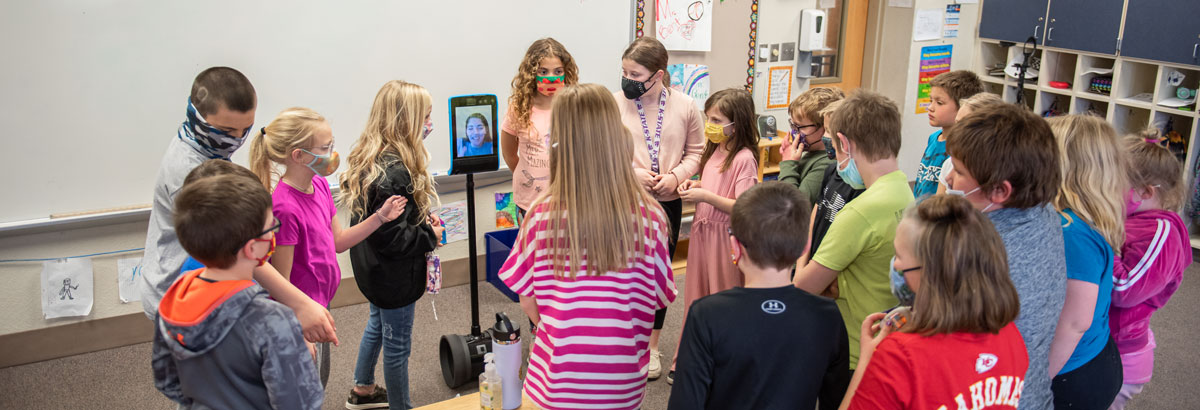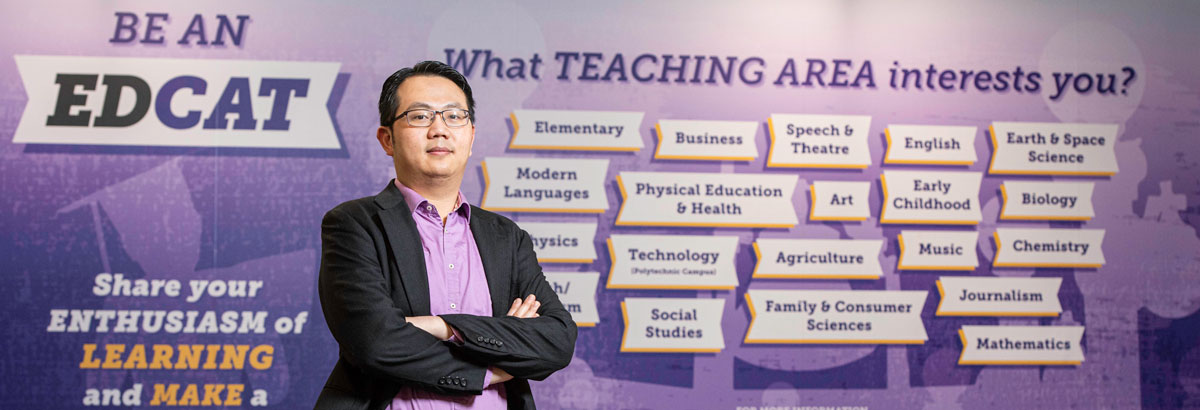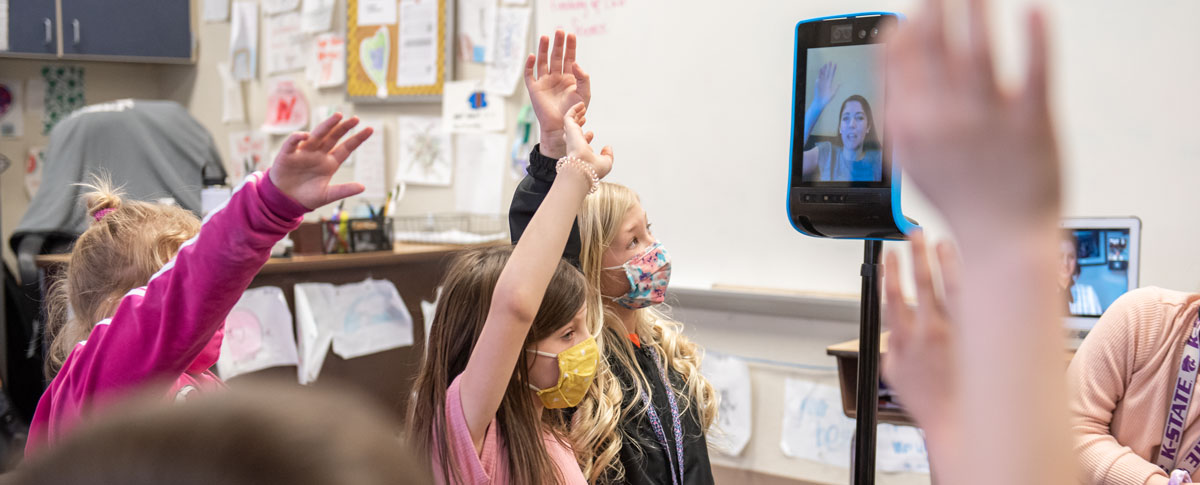College of Education brings research, robots together
Redefining the classroom
By Patrice Scott
Kansas State University College of Education researchers are connecting two worlds within the education system: the one before the COVID-19 pandemic and the one they are creating.
“We are redefining technology’s use in classrooms while defining its role in pedagogy,” said Debbie Mercer, dean of the College of Education. “By carefully selecting technology that allows us to be interactive, we are pushing the boundaries as we mold the future. This is a time of great opportunity.”
College of Education researchers are finding answers to many of education’s most complex questions.
How can we leverage technology to address teacher supply in rural America? What do teachers need? What factors affect a teacher’s decision to leave the profession?
A robotic solution

Rural schools need teachers, and teacher candidates need bustling schools and classrooms to complete their clinical semesters. Enter technology and research as a modern-day approach to K-State’s landgrant mission.
It began when an out-of-state K-State student needed a field experience placement to satisfy the requirements of her Master of Arts in Teaching, or MAT, program. Todd Goodson, professor and chair of the curriculum and instruction department, along with Tom Vontz, professor and director of the MAT program, and Eileen Wertzberger, coordinator of field experiences, suggested a novel approach: a telepresence robot.
A virtual teacher was a first for the university. It was also a first for Clay County USD 379, a member of the college’s Rural Education Center Rural Professional Development Schools Network. The school district agreed to the placement.
The future teacher became a virtual teacher at Lincoln Elementary School in Clay Center via a Double 2 robot, which is an iPad suspended on a self-balancing base. The iPad camera allowed the virtual teacher to maneuver around the classroom and interact with third grade students.
“This experience allowed us to see the ways in which we can use technology to facilitate field experiences that would otherwise not be possible,” Wertzberger said. “Ultimately, this experience was successful because of the vision and innovative spirit of the administrators and cooperating teacher involved. Their insights guided best practice and ensured not only a quality learning experience for the pre-service teacher, but also for the students in their care.”
The novel solution prompted Wertzberger to publish “The Future of Field Experiences in Distance Education: A Case Study of Co-Teaching Practices in a Telepresence- Facilitated Field Placement” in the national journal Theory & Practice in Rural Education.
“The data collected during the semester illuminates how the cooperating teacher and student teacher not only made the placement work but also relied on co-teaching practices that maximized the use of telepresence technology,” Wertzberger said.
The concept worked so well that Rural Education Center leaders Spencer Clark, director, and Lori Goodson, assistant director, received a $146,000 Teaching Rural Students STEM Through Telepresence grant from the U.S. Department of Agriculture. Researchers used the funds to purchase 38 Double Robotics robots, which allowed educators to teach and interact with their students at different locations. The nine schools from eight rural Kansas school districts also received iPads and laptops, as well as other equipment necessary for the project.
A few months later, Clark and Goodson received a second USDA grant — the largest grant the Rural Education Center has ever received — to expand the program in other districts throughout the state. The $451,000 grant involves 103 robots and 20 schools in 10 districts.
Rural school leaders are excited about what this means for students in their districts. Jamie Wetig, superintendent of USD 220 Ashland Public Schools, said teacher supply is always an issue in rural schools and the K-State partnership may help schools offer more class options to students.
“In an evermore challenging environment to recruit and retain highly qualified teachers, we look forward to expanding the opportunities afforded to USD 220 by the USDA telepresence grant and know this is just the beginning of using an innovative approach to support our students and our community,” Wetig said.
Mercer believes in the inherent power of education and the ability of college faculty members to support rural communities.
“We recognize the tremendous potential that exists in our rural students and are excited to take the lead in infusing our district partners with this innovative approach to STEM education,” Mercer said.
Reducing teacher turnover

Teacher preparation programs are graduating enough teachers to fill vacancies; but, teachers — especially early career educators in their first five years — are leaving the profession. College of Education researchers want to know why.
Tuan D. Nguyen, assistant professor of curriculum and instruction, has analyzed 120 national research projects that spanned 40 years and focused on teacher turnover.
The exhaustive review took more than 2 1/2 years and his data identified incentive and support programs as the keys to teacher retention. His research simultaneously disproved the long-held belief that performance evaluations drive teacher attrition.
Nguyen’s team published “The Correlates of Teacher Turnover: An Updated and Expanded Meta-Analysis of the Literature” in Educational Research Review, which is ranked second among educational research journals. Their meta-analysis offered new insights, identified underexamined factors and illuminated the connections between educational policy and teacher turnover. The data remained consistent for veteran teachers as well as early career educators and those in hard-to-staff areas, such as special needs and STEM fields that involve science, technology, engineering and math.
“This crucial study examined the evidence on what drove teachers to quit the profession or move from one school to another,” Nguyen said. “It has far-reaching implications for policymakers and school administrators in districts and states committed to reducing teacher turnover.”
The researchers discovered substantial evidence that improving school organizational characteristics, such as reducing student disciplinary problems, improving administrative support and supporting teacher collaborations, may reduce the risk of turnover. Moreover, despite some concerns of potential negative consequences of teacher evaluation and accountability from policymakers and educators, the data did not indicate that performance evaluations increase teacher attrition.
To the contrary, the research suggested that when teachers are evaluated and the results of their evaluations or measures of effectiveness are made available, teachers are not more likely to leave. In fact, the evidence indicated that teachers may be enticed to stay as they are provided with some urgency, sense of empowerment and evidence of areas for professional improvement.
Pandemic opens Pandora’s box

A sweeping research project conducted by a multidisciplinary team in the College of Education has identified the top needs and challenges K-12 teachers have faced during the COVID-19 pandemic.
More than 800 teachers in rural, urban and suburban school districts across the state participated in the project, “Access, Engagement and Resilience During COVID-19 Remote Learning.” The project centered on four key areas: technology/access, student/parent engagement, educator resiliency and social-emotional well-being. The survey was sent in May 2020, after the statewide transition to online learning in the early days of the pandemic.
The findings — used to inform policy for state and local leaders — revealed a myriad of strengths and weaknesses and identified universal needs for students’ social-emotional well-being, which was the teachers’ top concern; broadband internet access, which was deemed a dire need by teachers; educator well-being; and strengthening engagement in diverse learning environments.
The survey also showed several bright spots, particularly in the area of engagement:
- Teachers reported that 69% of students were considered highly to somewhat engaged in learning.
- Among rural teachers, 36% reported a higher level of engagement with their students, while 27% of all teachers reported that their personal engagement with students had increased.
- Nearly two-thirds — 64% — of educators reported an increase in personal engagement with parents during the pandemic.
In the areas of social-emotional well-being and technology and access, the survey proved prophetic.
Four out of five teachers listed social-emotional well-being as their highest concern. This included teachers across all school classifications, from 1A to 6A, and in rural, suburban and urban districts.
“My fear was that a mental health crisis was coming, and we have seen evidence of that in the news,” said Jessica Lane, a member of the research team and assistant professor of special education, counseling and student affairs. “The survey underscored the need for policymakers and administrators to address the mental health and social-emotional well-being of both our students and educators. It is critical.”
The shift to remote instruction also exposed significant inequities concerning technology and access to the internet. The survey found that broadband internet and educational technology were not consistently available in Kansas, and when they were, that did not translate to in-home access. This required teachers and districts to provide varied forms of instruction.
In addition to Lane, the other members of the multidisciplinary research team included Laura Bonella, associate professor at K-State Libraries; Doris Wright Carroll, associate professor of special education, counseling and student affairs; Morgan Jobe, program coordinator; Marilyn Kaff, associate professor of special education, counseling and student affairs; Tonnie Martinez, assistant professor of curriculum and instruction; Leah McKeeman, assistant professor of curriculum and instruction; and Cindy Shuman, associate dean for research.
Seek more
For a comprehensive look at the College of Education’s research and response to the COVID-19 pandemic, read more in the fall 2020 edition of Connections magazine.